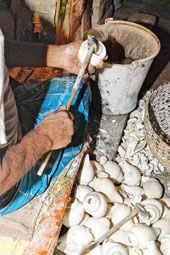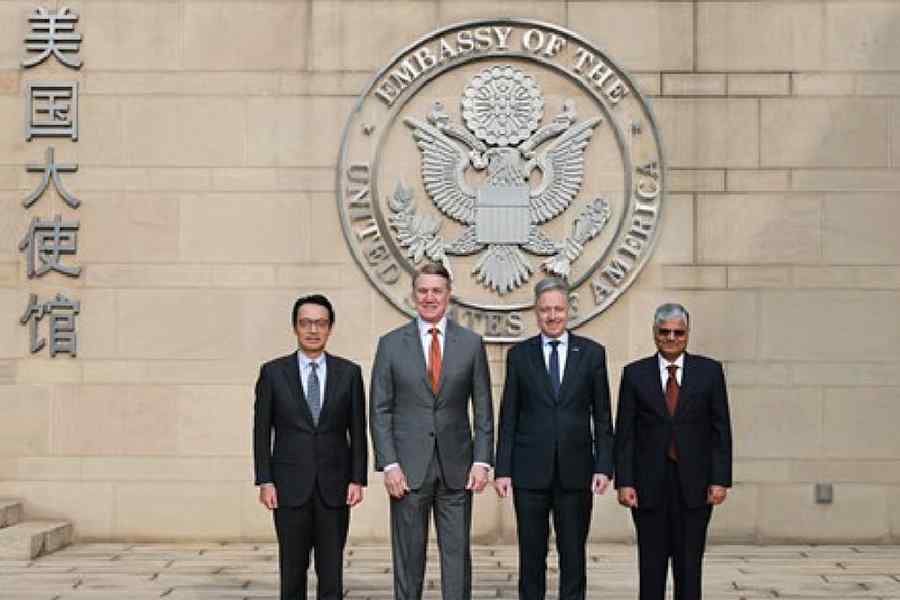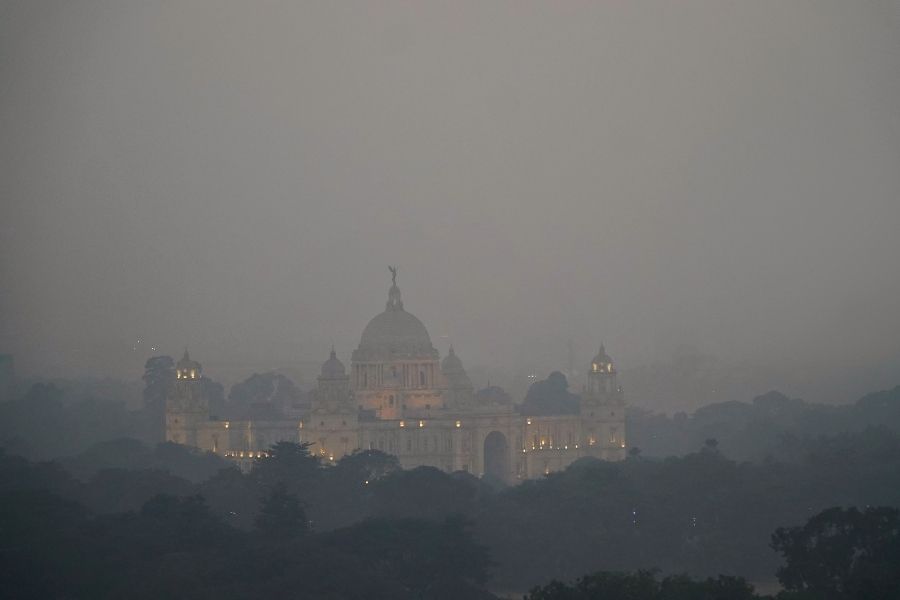 |
| A conch shell is being broken at its tail to carve out bangles |
 |
 |
| An array of designed conch shell bangles |
 |
| An artisan machines a bangle. |
 |
 |
| Bangles are being carved and polished for a fine finish |
 |
| Pictures by Gopal Senapati |
The milky white bangle that nestles between the red pala and the noya (iron bangle) in the forearms of the Bengali bride is an enduring symbol of matrimony in Bengal. Called sankha in Bengali, these bangles made of conch shells bestow a woman her status as a married woman in society as does the sindoor or vermilion in her forehead. But as with every other ritual and tradition that seems to be disappearing on the onslaught of westernisation, the wearing of sankha among married women, too, seems to get restricted.
In the villages of Bengal, however, young girls still visit the sankhari (maker of conch shell bangles) with their parents before their marriage to pick the bangles of their choice for ensuring long lives for their husbands and a happy married life. With time, patterns and designs of the bangles have changed. While some like to wear their sankhas designed with gold, others go for the simple white carved ones that look so pristine and pure.
While designs and styles of wearing the sankha has changed with time, a 200-year old sankha industry in Bantul in Howrah, is gradually on the brink of closure for lack of any government assistance. Once thriving, the sankha industry now is in doldrums due to inaccessibility to market, lack of infrastructure and modernization.
“This village is still known as Sankha-ripara as most of the families of this village are associated with this cottage industry. But these families now find it difficult to make both ends meet. They can no longer earn a decent living by making sankhas,” said Arup Das, a resident of Bantul, a government employee. According to the villagers, a few sankhari families migrated to Howrah from Senet in Hooghly in search of a suitable place near the bank of the Roopnarayan for setting up their workshops. They zeroed in on Bantul, that was then on the banks of Roopnarayan. It fell on the trade route of Tamralipta Bandar or Tamluk Port, making it easy for the traders to procure raw material, the conch shells, from distant markets and also send their finished products to the various markets through riverine route. The trade thus flourished on the banks of Roopnarayan. “Bantul, at one time, was on the bank of Roopnarayan that fell on the trade route of Tamralipta Bandar (Tamluk Port). Naturally, the sankha industry of Bantul was then profitable considering high demand for sankhas not only in Bengal but also in Odisha, Bihar and other eastern regions,” said Amal Roy, superintendent of archaeology, Directorate of Archaeology and Museums.
Rising prices sound the death knell
Most of the villagers, however, attributed the success of their forefathers in the sankha industry and the resultant affluence that they once enjoyed, to their community god Dadhi Bamanji.
“One night Dadhi Bamanji appeared in the dreams of one of our ancestors, a few days after his arrival at Bantul. Apparently, Dadhi Bamanji promised to donate a big boat full of sankha to help the Sankhari community in his dream. The next morning, he ran to the river bank and found an abandoned boat full of conch shells near the river ghat,” said Subrata Dutta, an artisan of the village. The villagers still worship the deity of Dadhi Bamanji with great devotion.
However, even the presiding deity’s blessings could do little for the industry that started dwindling with the receding of the Roopnarayan nearly 100 years ago. The supply line through river was no longer there and the artisans had to depend on surface transport for raw materials. Since the condition of the roads connecting the village was very bad and the only mode of communication then was bullock carts, transporting conch shells from Calcutta proved to be difficult. The problem, however, alleviated a little after the renovation of Bagnan-Shyampur Road and the introduction of public transport. Now conch shells come from Bagbazar, Kharagpur, Ghantal, Barrackpore and some other places on road.
“With the cost of raw materials rising every year, the profit margin for the traders dwindle drastically. Earlier, the state government agency, Manjusa, supplied raw materials at subsidised rates but they stopped doing that nearly 20 years ago. Now the margin of profit is so low that many villagers have stopped making the bangles and found other jobs instead,” said Prasanta Dutta, a villager.
 |
 |
| Artisans work on conch shells to carve out bangles from them. Pictures by Gopal Senapati |
Most of the artisans now work for the big sankha traders. The artisans need a polishing machine and a designing machine to make the bangles. “The traders send us sack full of sankhas. We take them to a local factory to cut them in pieces. Then we polish them and make designs on them. But the margin of profit is so low that I just manage to arrange two square meals a day,” said Biswajit Dutta, an artisan. Biswajit’s wife and a younger brother help him in finishing and designing the sankha.
The artisans allege that traders keep most of the profit for themselves leaving little for the poor artisans. “If the government resumes supplying raw material at subsidised rates, we can make good money,” said an artisan. The small traders also alleged that the suppliers raise the prices of conch shells at will. “The suppliers get their supply from Tuticorin in Tamil Nadu and Puri and Balasore in Odisha at much cheaper prices. If any government agency gets the supply from Tamil Nadu or Odisha then we shall be able to get the conch shells at half the price,” said Uttam Das, an artisan.
Arunima Dey, the managing director of Manjusa, said, “Till 1991, the state government bought the conch shells directly from the Tamil Nadu government. But after Jayalalitha came to power she decided to sell the shells through auction. We could no longer compete with the private traders who made higher bids.”
The rising price of sankha is also a cause of concern. The price of a pair was not more than Rs 300. But now it has doubled. Earlier, women used to wear the bangles as long as their husbands lived. Now most wear them only during their wedding,” said Ashoka Das, a woman of this sankhari community.










